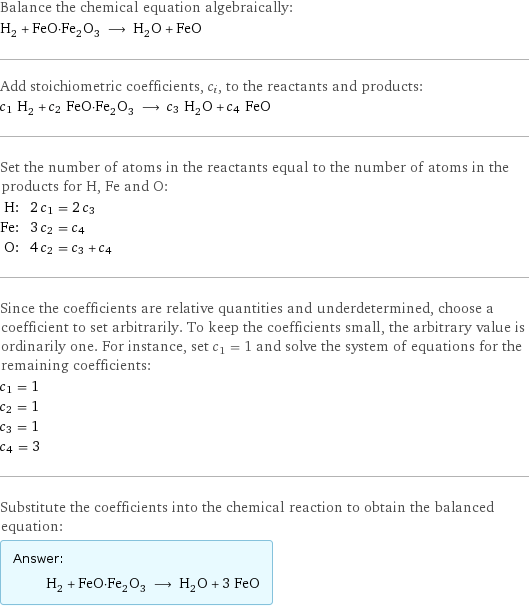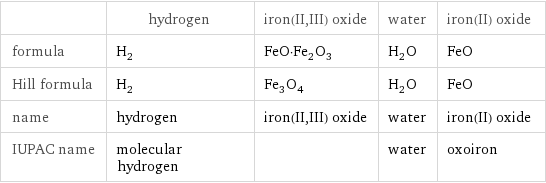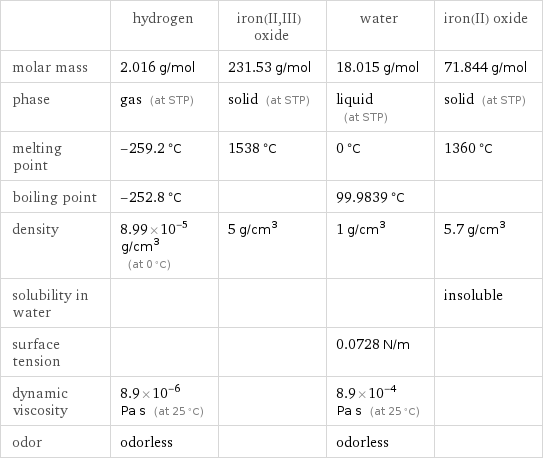Input interpretation

H_2 hydrogen + FeO·Fe_2O_3 iron(II, III) oxide ⟶ H_2O water + FeO iron(II) oxide
Balanced equation

Balance the chemical equation algebraically: H_2 + FeO·Fe_2O_3 ⟶ H_2O + FeO Add stoichiometric coefficients, c_i, to the reactants and products: c_1 H_2 + c_2 FeO·Fe_2O_3 ⟶ c_3 H_2O + c_4 FeO Set the number of atoms in the reactants equal to the number of atoms in the products for H, Fe and O: H: | 2 c_1 = 2 c_3 Fe: | 3 c_2 = c_4 O: | 4 c_2 = c_3 + c_4 Since the coefficients are relative quantities and underdetermined, choose a coefficient to set arbitrarily. To keep the coefficients small, the arbitrary value is ordinarily one. For instance, set c_1 = 1 and solve the system of equations for the remaining coefficients: c_1 = 1 c_2 = 1 c_3 = 1 c_4 = 3 Substitute the coefficients into the chemical reaction to obtain the balanced equation: Answer: | | H_2 + FeO·Fe_2O_3 ⟶ H_2O + 3 FeO
Structures

+ ⟶ +
Names

hydrogen + iron(II, III) oxide ⟶ water + iron(II) oxide
Reaction thermodynamics
Enthalpy

| hydrogen | iron(II, III) oxide | water | iron(II) oxide molecular enthalpy | 0 kJ/mol | -1118 kJ/mol | -285.8 kJ/mol | -272 kJ/mol total enthalpy | 0 kJ/mol | -1118 kJ/mol | -285.8 kJ/mol | -816 kJ/mol | H_initial = -1118 kJ/mol | | H_final = -1102 kJ/mol | ΔH_rxn^0 | -1102 kJ/mol - -1118 kJ/mol = 16.57 kJ/mol (endothermic) | | |
Gibbs free energy

| hydrogen | iron(II, III) oxide | water | iron(II) oxide molecular free energy | 0 kJ/mol | -1015 kJ/mol | -237.1 kJ/mol | -255 kJ/mol total free energy | 0 kJ/mol | -1015 kJ/mol | -237.1 kJ/mol | -765 kJ/mol | G_initial = -1015 kJ/mol | | G_final = -1002 kJ/mol | ΔG_rxn^0 | -1002 kJ/mol - -1015 kJ/mol = 13.3 kJ/mol (endergonic) | | |
Equilibrium constant
![Construct the equilibrium constant, K, expression for: H_2 + FeO·Fe_2O_3 ⟶ H_2O + FeO Plan: • Balance the chemical equation. • Determine the stoichiometric numbers. • Assemble the activity expression for each chemical species. • Use the activity expressions to build the equilibrium constant expression. Write the balanced chemical equation: H_2 + FeO·Fe_2O_3 ⟶ H_2O + 3 FeO Assign stoichiometric numbers, ν_i, using the stoichiometric coefficients, c_i, from the balanced chemical equation in the following manner: ν_i = -c_i for reactants and ν_i = c_i for products: chemical species | c_i | ν_i H_2 | 1 | -1 FeO·Fe_2O_3 | 1 | -1 H_2O | 1 | 1 FeO | 3 | 3 Assemble the activity expressions accounting for the state of matter and ν_i: chemical species | c_i | ν_i | activity expression H_2 | 1 | -1 | ([H2])^(-1) FeO·Fe_2O_3 | 1 | -1 | ([FeO·Fe2O3])^(-1) H_2O | 1 | 1 | [H2O] FeO | 3 | 3 | ([FeO])^3 The equilibrium constant symbol in the concentration basis is: K_c Mulitply the activity expressions to arrive at the K_c expression: Answer: | | K_c = ([H2])^(-1) ([FeO·Fe2O3])^(-1) [H2O] ([FeO])^3 = ([H2O] ([FeO])^3)/([H2] [FeO·Fe2O3])](../image_source/c01c44671802203a3781d75c9ac4e740.png)
Construct the equilibrium constant, K, expression for: H_2 + FeO·Fe_2O_3 ⟶ H_2O + FeO Plan: • Balance the chemical equation. • Determine the stoichiometric numbers. • Assemble the activity expression for each chemical species. • Use the activity expressions to build the equilibrium constant expression. Write the balanced chemical equation: H_2 + FeO·Fe_2O_3 ⟶ H_2O + 3 FeO Assign stoichiometric numbers, ν_i, using the stoichiometric coefficients, c_i, from the balanced chemical equation in the following manner: ν_i = -c_i for reactants and ν_i = c_i for products: chemical species | c_i | ν_i H_2 | 1 | -1 FeO·Fe_2O_3 | 1 | -1 H_2O | 1 | 1 FeO | 3 | 3 Assemble the activity expressions accounting for the state of matter and ν_i: chemical species | c_i | ν_i | activity expression H_2 | 1 | -1 | ([H2])^(-1) FeO·Fe_2O_3 | 1 | -1 | ([FeO·Fe2O3])^(-1) H_2O | 1 | 1 | [H2O] FeO | 3 | 3 | ([FeO])^3 The equilibrium constant symbol in the concentration basis is: K_c Mulitply the activity expressions to arrive at the K_c expression: Answer: | | K_c = ([H2])^(-1) ([FeO·Fe2O3])^(-1) [H2O] ([FeO])^3 = ([H2O] ([FeO])^3)/([H2] [FeO·Fe2O3])
Rate of reaction
![Construct the rate of reaction expression for: H_2 + FeO·Fe_2O_3 ⟶ H_2O + FeO Plan: • Balance the chemical equation. • Determine the stoichiometric numbers. • Assemble the rate term for each chemical species. • Write the rate of reaction expression. Write the balanced chemical equation: H_2 + FeO·Fe_2O_3 ⟶ H_2O + 3 FeO Assign stoichiometric numbers, ν_i, using the stoichiometric coefficients, c_i, from the balanced chemical equation in the following manner: ν_i = -c_i for reactants and ν_i = c_i for products: chemical species | c_i | ν_i H_2 | 1 | -1 FeO·Fe_2O_3 | 1 | -1 H_2O | 1 | 1 FeO | 3 | 3 The rate term for each chemical species, B_i, is 1/ν_i(Δ[B_i])/(Δt) where [B_i] is the amount concentration and t is time: chemical species | c_i | ν_i | rate term H_2 | 1 | -1 | -(Δ[H2])/(Δt) FeO·Fe_2O_3 | 1 | -1 | -(Δ[FeO·Fe2O3])/(Δt) H_2O | 1 | 1 | (Δ[H2O])/(Δt) FeO | 3 | 3 | 1/3 (Δ[FeO])/(Δt) (for infinitesimal rate of change, replace Δ with d) Set the rate terms equal to each other to arrive at the rate expression: Answer: | | rate = -(Δ[H2])/(Δt) = -(Δ[FeO·Fe2O3])/(Δt) = (Δ[H2O])/(Δt) = 1/3 (Δ[FeO])/(Δt) (assuming constant volume and no accumulation of intermediates or side products)](../image_source/116a289d2009a5bb319a9241cc7898df.png)
Construct the rate of reaction expression for: H_2 + FeO·Fe_2O_3 ⟶ H_2O + FeO Plan: • Balance the chemical equation. • Determine the stoichiometric numbers. • Assemble the rate term for each chemical species. • Write the rate of reaction expression. Write the balanced chemical equation: H_2 + FeO·Fe_2O_3 ⟶ H_2O + 3 FeO Assign stoichiometric numbers, ν_i, using the stoichiometric coefficients, c_i, from the balanced chemical equation in the following manner: ν_i = -c_i for reactants and ν_i = c_i for products: chemical species | c_i | ν_i H_2 | 1 | -1 FeO·Fe_2O_3 | 1 | -1 H_2O | 1 | 1 FeO | 3 | 3 The rate term for each chemical species, B_i, is 1/ν_i(Δ[B_i])/(Δt) where [B_i] is the amount concentration and t is time: chemical species | c_i | ν_i | rate term H_2 | 1 | -1 | -(Δ[H2])/(Δt) FeO·Fe_2O_3 | 1 | -1 | -(Δ[FeO·Fe2O3])/(Δt) H_2O | 1 | 1 | (Δ[H2O])/(Δt) FeO | 3 | 3 | 1/3 (Δ[FeO])/(Δt) (for infinitesimal rate of change, replace Δ with d) Set the rate terms equal to each other to arrive at the rate expression: Answer: | | rate = -(Δ[H2])/(Δt) = -(Δ[FeO·Fe2O3])/(Δt) = (Δ[H2O])/(Δt) = 1/3 (Δ[FeO])/(Δt) (assuming constant volume and no accumulation of intermediates or side products)
Chemical names and formulas

| hydrogen | iron(II, III) oxide | water | iron(II) oxide formula | H_2 | FeO·Fe_2O_3 | H_2O | FeO Hill formula | H_2 | Fe_3O_4 | H_2O | FeO name | hydrogen | iron(II, III) oxide | water | iron(II) oxide IUPAC name | molecular hydrogen | | water | oxoiron
Substance properties

| hydrogen | iron(II, III) oxide | water | iron(II) oxide molar mass | 2.016 g/mol | 231.53 g/mol | 18.015 g/mol | 71.844 g/mol phase | gas (at STP) | solid (at STP) | liquid (at STP) | solid (at STP) melting point | -259.2 °C | 1538 °C | 0 °C | 1360 °C boiling point | -252.8 °C | | 99.9839 °C | density | 8.99×10^-5 g/cm^3 (at 0 °C) | 5 g/cm^3 | 1 g/cm^3 | 5.7 g/cm^3 solubility in water | | | | insoluble surface tension | | | 0.0728 N/m | dynamic viscosity | 8.9×10^-6 Pa s (at 25 °C) | | 8.9×10^-4 Pa s (at 25 °C) | odor | odorless | | odorless |
Units
